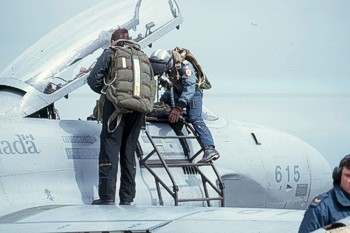Canada
was one of the last three countries in NATO flying the T-33, with 19 Wing being one of
them. In Canadian service the bird is known as the CT-133 Silver Star. Over 45 years old,
the nine T-33s, or "T-Birds" with 19 Wing's 414 Squadron, were used for, jamming
electronics, simulating missiles and acting as an enemy force in training exercises. The
T-Bird fleet phase out began on March 31, 2002.

Flightgear Online was invited to see the
T-Birds at work during May 2001 at CFB Comox. This report will take a closer look on their
operations and flight equipment. 414 Sqn was known as the Black Knights.
Operations
The Lockheed T-33 was acquired by the RCAF in the early '50s. It initially served as an
intermediate trainer for the conversion of pilots from propeller-type Aircraft to advanced
jet fighters.
Since then, it has been used almost exclusively for electronic warfare (CE-133 version) -
simulating various levels of threats, fighters, bombers, strike Aircraft, cruise missiles
and drug ferrying Aircraft. Although limited in power and speed, the T-Bird is capable of
carrying out most of the maneuvers of the CF-18 (albeit slower), providing the fighter
pilots with aggressor support to hone their skills. The Silver Stars small radar cross
section, combined with low level flying, made it very difficult to detect on radar.

In a naval live-fire exercise, the T-Bird was
equipped with either a RADOP that has a reflector inside for the ship's radar to track or
lock into or a missed distance indicator to sense the proximity of passing projectiles.
In 1996, 414 Squadron saw the introduction of
the long awaited avionics updated T-33. As part of the new package, the T-33 was equipped
with VOR/ILS, a radar altimeter, a VHF radio and updated instruments. During 2001 the
Silver Star underwent an ejection seat upgrade. Lengthy periodic maintenance inspections
were carried out at 414 Squadron for all remaining CT-133s in Canada.
Flight equipment
As CFB Comox is located at Vancouver Island, most flights take place over water. Therefore
pilots were fitted out with the Mustang survival/life preserver. When water temperature
became to low, pilots also were wearing the immersion drysuit made of PTFE Goretex
material. (Label says “coveralls, flying, anti-exposure, immersion CF”). Also
made by Mustang Industries Inc.
The flight suit comes in different colors, although most seen were black and blue ones
(Label: “Flying, Coveralls, Combat AF” followed by the color). The flight jacket
used is made of aprox. 65% cotton and 35% nylon. This jacket comes in intermediate and
winter style and several colors (black, blue, green, orange). The winter style type IV
flight jacket is thicker and has a collar added and both types are made by Outdoor Outfits
Limited, who also makes some of the flight suits. During their operations, no g-suits are
worn.

The pilot used a back style parachute. His
helmet worn was the current use Canadian Gentex DH 190A. Made of fiberglass fabric with an
epoxy resin, this helmet is used with a light weight snap-on visor assembly and TPL. The
Black Knights also had reflective striping on their helmets to improve visibility for SAR
teams. The oxygen mask was an improved version of the standard MBU-12/P. The mask has an
extra opening on the left side (little gray port). The oxygen hose is fitted with an MC-3
like connector.
Sadly enough, most Silver Star operations with the Canadian Air Force halted, but four
CT-133 Aircraft will be retained for ongoing use as test support assets. This time at CFB
Cold Lake.
We would like to thank WO William C Ford and LT (N) John Coppard for their help. |